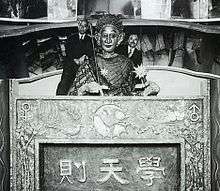Gakutensoku

Gakutensoku (學天則, Japanese for "learning from the laws of nature"), the first robot to be built in Japan, was created in Osaka in 1929. The robot was designed and manufactured by biologist Makoto Nishimura (1883-1956, father of actor Ko Nishimura). Nishimura had served as a professor at Hokkaido Imperial University, studied Marimo and was an editorial adviser to the Osaka Mainichi newspaper (now the Mainichi Shimbun).
Description
Gakutensoku could change its facial expression and move its head and hands via an air pressure mechanism. It had a pen-shaped Signal arrow in its right hand and a lamp named Reikantō (霊感灯, Japanese for "inspiration light") in its left hand. Perched on top of Gakutensoku was a bird-shaped robot named Kokukyōchō (告暁鳥, Japanese for "bird informing dawn"). When Kokukyōchō cried, Gakutensoku's eyes closed and its expression became pensive. When the lamp shone, Gakutensoku started to write words with the pen.
Gakutensoku was displayed at some expositions in Japan, but was lost while touring Germany in the 1930s.
Legacy
An asteroid, 9786 Gakutensoku, was named after the robot.
A modern version of Gakutensoku was produced in 2008 by the Osaka Science Museum, where it is now on display.
Cultural references
- Gakutensoku and its creator, Makoto Nishimura, appear in Hiroshi Aramata's novel Teito Monogatari and the subsequent film based on the novel. In the film Makoto is portrayed by his real life son Ko Nishimura.
- A similar robot named Hisoutensoku is the main feature of the fighting game Touhou Hisōtensoku and was inspired from the Gakutensoku.